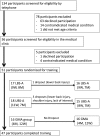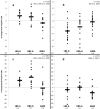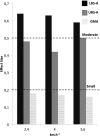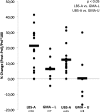Multiple roads lead to Rome: combined high-intensity aerobic and strength training vs. gross motor activities leads to equivalent improvement in executive functions in a cohort of healthy older adults
- PMID: 25194940
- PMCID: PMC4156938
- DOI: 10.1007/s11357-014-9710-8
Multiple roads lead to Rome: combined high-intensity aerobic and strength training vs. gross motor activities leads to equivalent improvement in executive functions in a cohort of healthy older adults
Abstract
The effects of physical activity on cognition in older adults have been extensively investigated in the last decade. Different interventions such as aerobic, strength, and gross motor training programs have resulted in improvements in cognitive functions. However, the mechanisms underlying the relationship between physical activity and cognition are still poorly understood. Recently, it was shown that acute bouts of exercise resulted in reduced executive control at higher relative exercise intensities. Considering that aging is characterized by a reduction in potential energy ([Formula: see text] max - energy cost of walking), which leads to higher relative walking intensity for the same absolute speed, it could be argued that any intervention aimed at reducing the relative intensity of the locomotive task would improve executive control while walking. The objective of the present study was to determine the effects of a short-term (8 weeks) high-intensity strength and aerobic training program on executive functions (single and dual task) in a cohort of healthy older adults. Fifty-one participants were included and 47 (age, 70.7 ± 5.6) completed the study which compared the effects of three interventions: lower body strength + aerobic training (LBS-A), upper body strength + aerobic training (UBS-A), and gross motor activities (GMA). Training sessions were held 3 times every week. Both physical fitness (aerobic, neuromuscular, and body composition) and cognitive functions (RNG) during a dual task were assessed before and after the intervention. Even though the LBS-A and UBS-A interventions increased potential energy to a higher level (Effect size: LBS-A-moderate, UBS-A-small, GMA-trivial), all groups showed equivalent improvement in cognitive function, with inhibition being more sensitive to the intervention. These findings suggest that different exercise programs targeting physical fitness and/or gross motor skills may lead to equivalent improvement in cognition in healthy older adults. Such results call for further investigation of the multiple physiological pathways by which physical exercise can impact cognition in older adults.
Figures
Similar articles
-
Gross Motor Skills Training Leads to Increased Brain-Derived Neurotrophic Factor Levels in Healthy Older Adults: A Pilot Study.Front Physiol. 2019 Apr 12;10:410. doi: 10.3389/fphys.2019.00410. eCollection 2019. Front Physiol. 2019. PMID: 31031639 Free PMC article.
-
A comparison of the impact of physical exercise, cognitive training and combined intervention on spontaneous walking speed in older adults.Aging Clin Exp Res. 2018 Aug;30(8):921-925. doi: 10.1007/s40520-017-0878-5. Epub 2017 Dec 12. Aging Clin Exp Res. 2018. PMID: 29235076 Clinical Trial.
-
A 9-Week Aerobic and Strength Training Program Improves Cognitive and Motor Function in Patients with Dementia: A Randomized, Controlled Trial.Am J Geriatr Psychiatry. 2015 Nov;23(11):1106-16. doi: 10.1016/j.jagp.2014.12.191. Epub 2015 Jan 3. Am J Geriatr Psychiatry. 2015. PMID: 25648055 Clinical Trial.
-
Physical Activity to Counter Age-Related Cognitive Decline: Benefits of Aerobic, Resistance, and Combined Training-A Narrative Review.Sports Med Open. 2025 May 17;11(1):56. doi: 10.1186/s40798-025-00857-2. Sports Med Open. 2025. PMID: 40381170 Free PMC article. Review.
-
Effect of Combined Physical and Cognitive Interventions on Executive Functions in OLDER Adults: A Meta-Analysis of Outcomes.Int J Environ Res Public Health. 2020 Aug 25;17(17):6166. doi: 10.3390/ijerph17176166. Int J Environ Res Public Health. 2020. PMID: 32854323 Free PMC article. Review.
Cited by
-
Bridging the Gap between Research and the Community: Implementing Physical and Cognitive Interventions to Improve Spontaneous Walking Speed in Older Adults.Int J Environ Res Public Health. 2022 Dec 31;20(1):762. doi: 10.3390/ijerph20010762. Int J Environ Res Public Health. 2022. PMID: 36613083 Free PMC article. Clinical Trial.
-
How Older Adults Cope with Cognitive Complexity and Environmental Constraints during Dual-Task Walking: The Role of Executive Function Involvement.Int J Environ Res Public Health. 2019 May 23;16(10):1835. doi: 10.3390/ijerph16101835. Int J Environ Res Public Health. 2019. PMID: 31126116 Free PMC article.
-
Aerobic training as a means to enhance inhibition: what's yet to be studied?Eur Rev Aging Phys Act. 2015 Dec 24;12:14. doi: 10.1186/s11556-015-0160-9. eCollection 2015. Eur Rev Aging Phys Act. 2015. PMID: 26865878 Free PMC article.
-
Skeletal Muscle Health and Cognitive Function: A Narrative Review.Int J Mol Sci. 2020 Dec 29;22(1):255. doi: 10.3390/ijms22010255. Int J Mol Sci. 2020. PMID: 33383820 Free PMC article. Review.
-
Relationships between lower body strength and the energy cost of treadmill walking in a cohort of healthy older adults: a cross-sectional analysis.Eur J Appl Physiol. 2017 Jan;117(1):53-59. doi: 10.1007/s00421-016-3498-4. Epub 2016 Nov 4. Eur J Appl Physiol. 2017. PMID: 27815704
References
-
- Angevaren M, Aufdemkampe G, Verhaar HJ, Aleman A, Vanhees L. Physical activity and enhanced fitness to improve cognitive function in older people without known cognitive impairment. Cochrane Database Syst Rev. 2008;3:CD005381. - PubMed
-
- Baker LD, Frank LL, Foster-Schubert K, Green PS, Wilkinson CW, McTiernan A, Plymate SR, Fishel MA, Watson GS, Cholerton BA, Duncan GE, Mehta PD, Craft S. Effects of aerobic exercise on mild cognitive impairment: a controlled trial. Arch Neurol. 2010;67(1):71–79. doi: 10.1001/archneurol.2009.307. - DOI - PMC - PubMed
Publication types
MeSH terms
Grants and funding
LinkOut - more resources
Full Text Sources
Other Literature Sources
Medical
Miscellaneous




